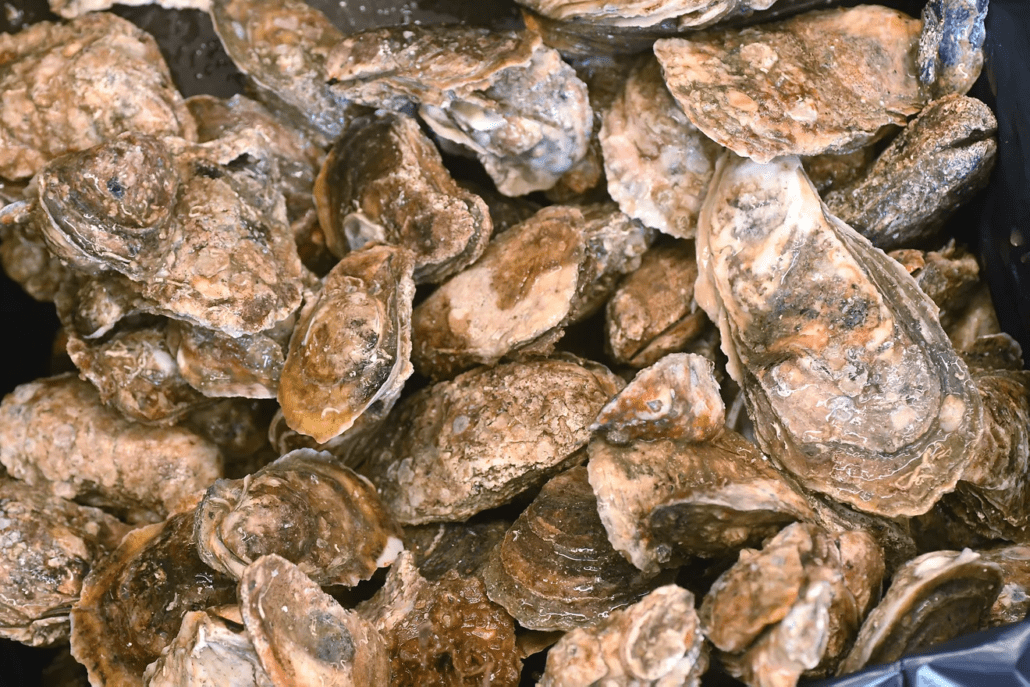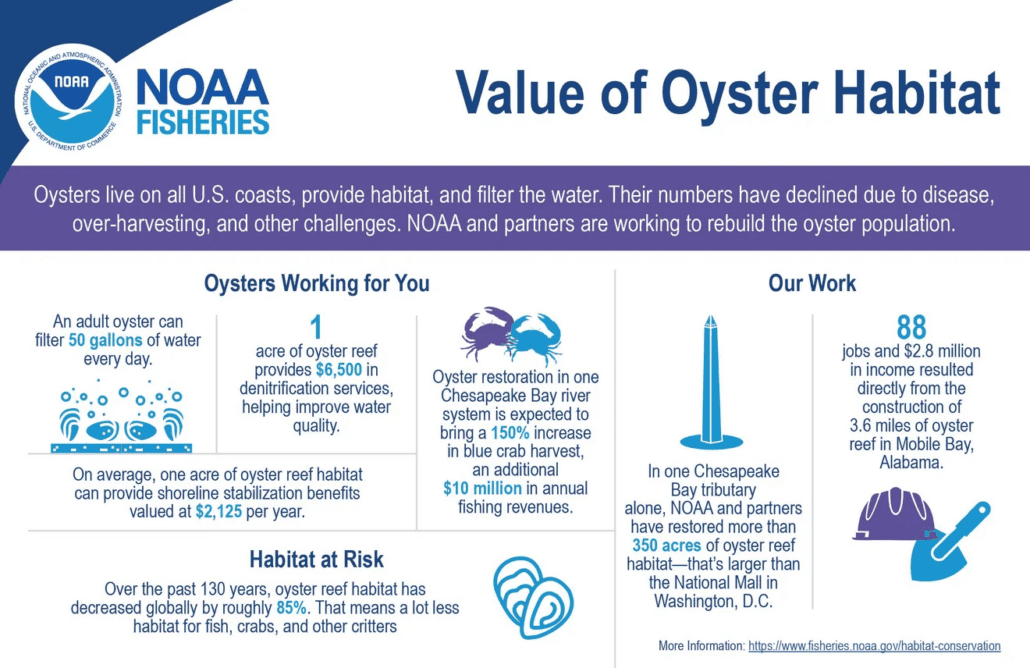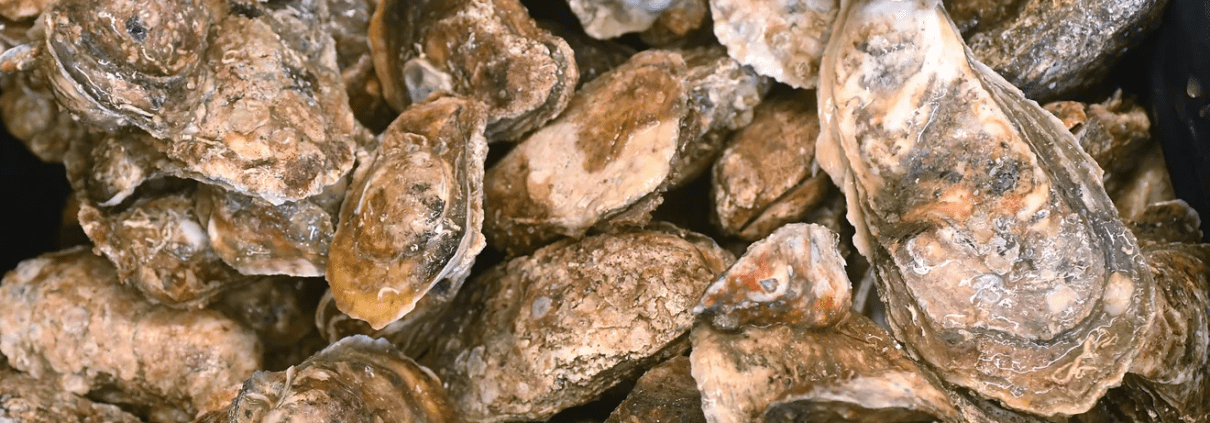As NC celebrates oyster month, here’s a look at the state’s most popular shellfish
Once common and wide spread along the N.C. coast, the oyster is making a comeback thanks to sanctuaries and shellfish farmers. But many challenges remain for the small, but popular mollusk
by Gareth McGrath on October 22, 2024 | Reprinted from Star News Online

Image by Ken Blevins
As oyster lovers slurp their way through October, honoring their favorite bivalve during N.C. Oyster Month, the health of the state’s mollusk fishery appears to be on an upward trajectory.
After two decades of concerted efforts by the state, research institutions and environmental groups to help oysters − and the industry they support − bounce back in North Carolina’s coastal waters, the small shellfish is back playing an outsized role in the state’s coastal environment and economy.
But a slew of obstacles still stalk the fishery, from disease to declining water quality to broad opposition from waterfront property owners to the expansion of shellfish farms.
And while the state’s oyster reefs will never match what North Carolina used to have in its extensive sounds and coastal waters, with some estimates that as much as 90% of the state’s historical reefs have been lost over the past century, there is hope the situation, if not at least stabilized, is improving for the state’s most popular shellfish.
NC Oyster Season:Getting to know Ana Shellem, a local fisherman and oyster harvester
Declining water quality, habitats
Once so plentiful that they formed an important trading commodity and food source for the state’s early residents, oysters have always played an important role in North Carolina’s coastal culture, cuisine and economy.
But the tide began turning against the oyster in the late 19th century, a trend that only accelerated into the 20th century. Unsustainable harvesting depleted oyster beds and onshore development, including timbering and agricultural uses, degraded habitat, allowing sediment and nutrients to flood into coastal waters.
More recently, the massive influx of people drawn to the ocean has heaped more pressure on the mollusks.
As oyster populations have declined, so has the quality of the state’s coastal waters.
Oyster reefs serve as vital habitat for a host of fish and other marine critters and also as natural wave breaks − think living shorelines − to help naturally absorb and disperse tidal energy that can erode and destroy shorelines and damage waterfront structures and infrastructure.
But it is as filter feeders that oysters might have their most important and profound impact on North Carolina’s coastal environment. Each oyster can pump up to 50 gallons of water through its body everyday, removing nutrients and algae from the water. That, in turn, creates clearer and cleaner water for marine life to grow and thrive.

Image Courtesy of NOAA
‘An insurance policy for our wild population’
The status of the state’s wild oyster population is a bit of an unknown, with no stock assessment done in recent times.
But by one measure, the harvesting of wild oysters, the population appears to at least be stable at about 50,000 bushels, each of which weighs 55 pounds, a year.
That doesn’t mean, however, that groups like the N.C. Coastal Federation aren’t offering the little shellfish a helping hand.
In Pamlico Sound, the coastal environmental group has worked with the N.C. Division of Marine Fisheries and other partners to build several large manmade reefs, including 40 acres this year and another 40 acres next year, that double as oyster sanctuaries and are off limits to commercial harvesting.
Erin Fleckenstein, the federation’s oyster program director, said the protected reefs account for only 6% of the oyster reefs in the sound, but represent 20% of the waterway’s oyster population and produce 25% of the sound’s spat, or oyster babies.
“These oyster sanctuaries serve as an insurance policy for our wild population,” she said.
But pressures on the state’s oysters aren’t decreasing. Key among them is the massive growth many of the state’s coastal areas, including around the Wilmington area, have seen in recent decades. Fleckenstein said that has researchers starting to look at taking a watershed approach to protecting water quality, including looking at steps that can be taken upstream or well away from the water’s edge.

Image by Paul Stephen
‘Something North Carolina can and should be proud of’
As the state’s wild oyster population continues to face challenges, shellfish farmers like Chris Matteo, owner of Chadwick Creek Oysters and Seed Nursery in Bayboro near New Bern, are stepping up.
When Matteo, who also heads the N.C. Shellfish Growers Association, got into the water-dependent farming industry a little over a decade ago, he could count the state’s number of commercial shellfish farmers on one hand.
“Now there are roughly 130 farmers generating jobs and income all along the coast, and we’re filtering a half-billion gallons of estuarine water a day for free, and that’s not an insignificant impact,” he said.
But like their wild brethren, farm-raised oysters face obstacles. Disease has always been a threat, and a recent spate of mass-mortality events has shellfish farmers and researchers scrambling to find the source. Then there’s the NIMBY worries of some coastal residents to having oyster cages visible from their waterfront homes, and the weather − including too much or too little fresh water − is always a concern, Matteo said.
OYSTER FARMING:Why the pearl in NC’s agriculture industry is running into choppy waters

Image Provided by Chris Matteo
Still, the industry is thriving and now represents roughly 70% of the oysters harvested in North Carolina, generating nearly $18 million for shellfish farmers, Matteo said.
And for tourists (and even some locals) there’s always the allure of trying something homegrown when visiting the coast. Matteo said that’s especially true when it comes to a raw product like oysters, where people realize if it’s sourced locally that means less time out of the water and a fresher product.
“We’re making progress on nearly all fronts, and that’s critical in a relatively new industry like ours,” Matteo said. “It’s something North Carolina can and should be proud of.”
Reporter Gareth McGrath can be reached at GMcGrath@Gannett.com or @GarethMcGrathSN on X/Twitter. This story was produced with financial support from the Green South Foundation and the Prentice Foundation. The USA TODAY Network maintains full editorial control of the work.




